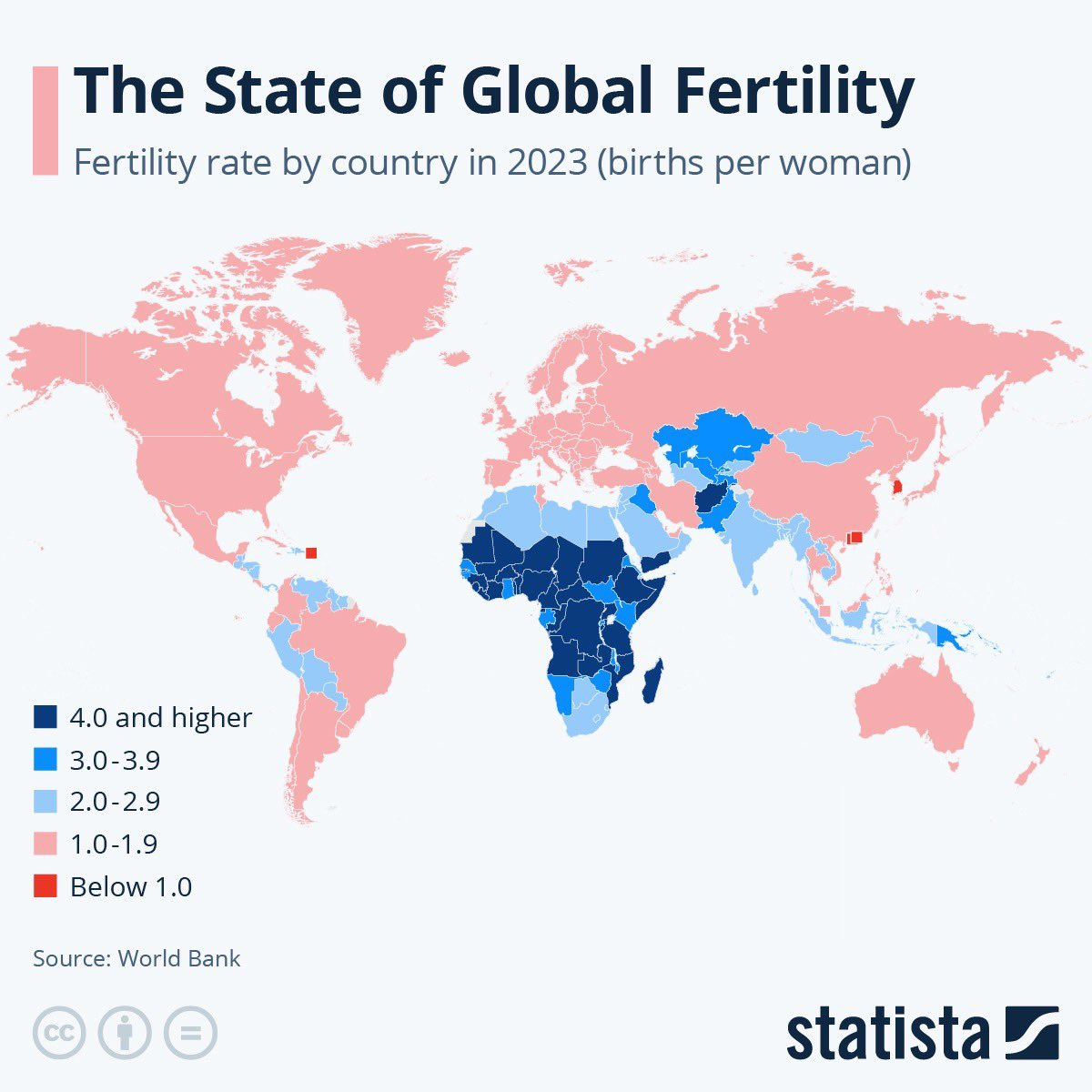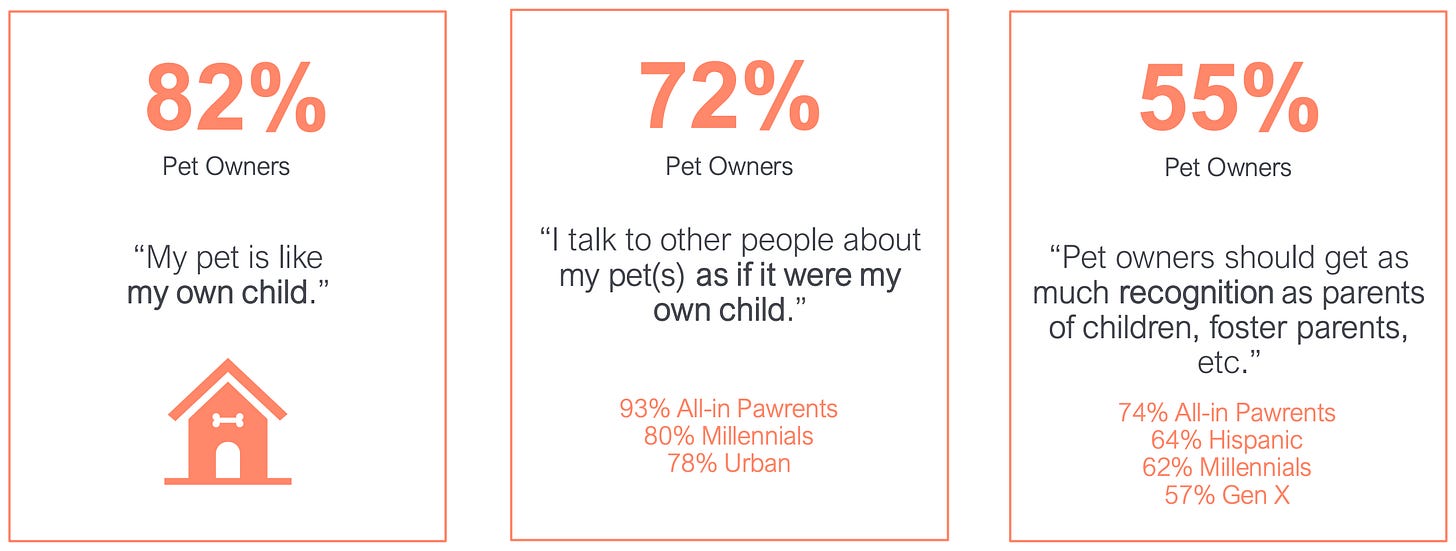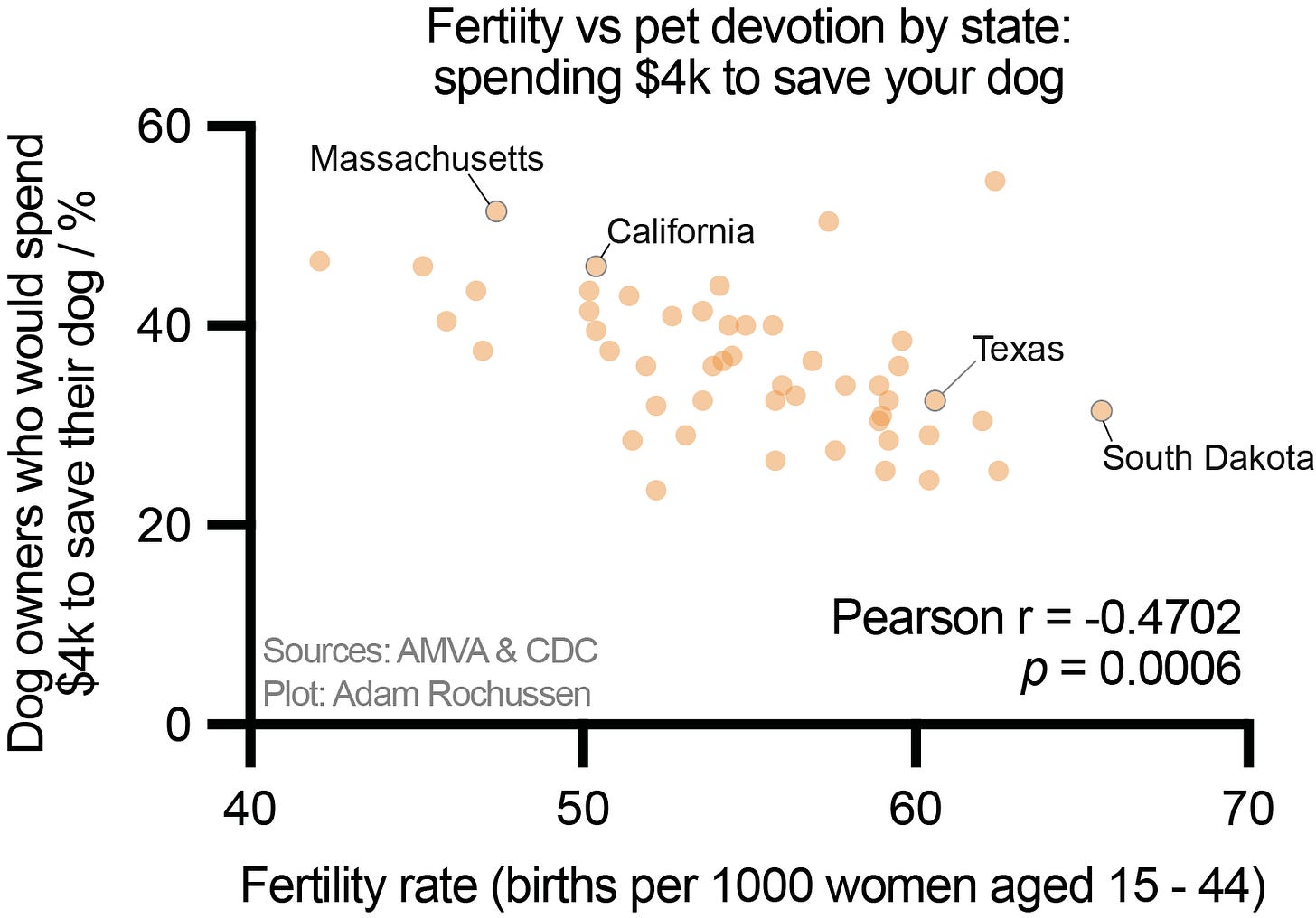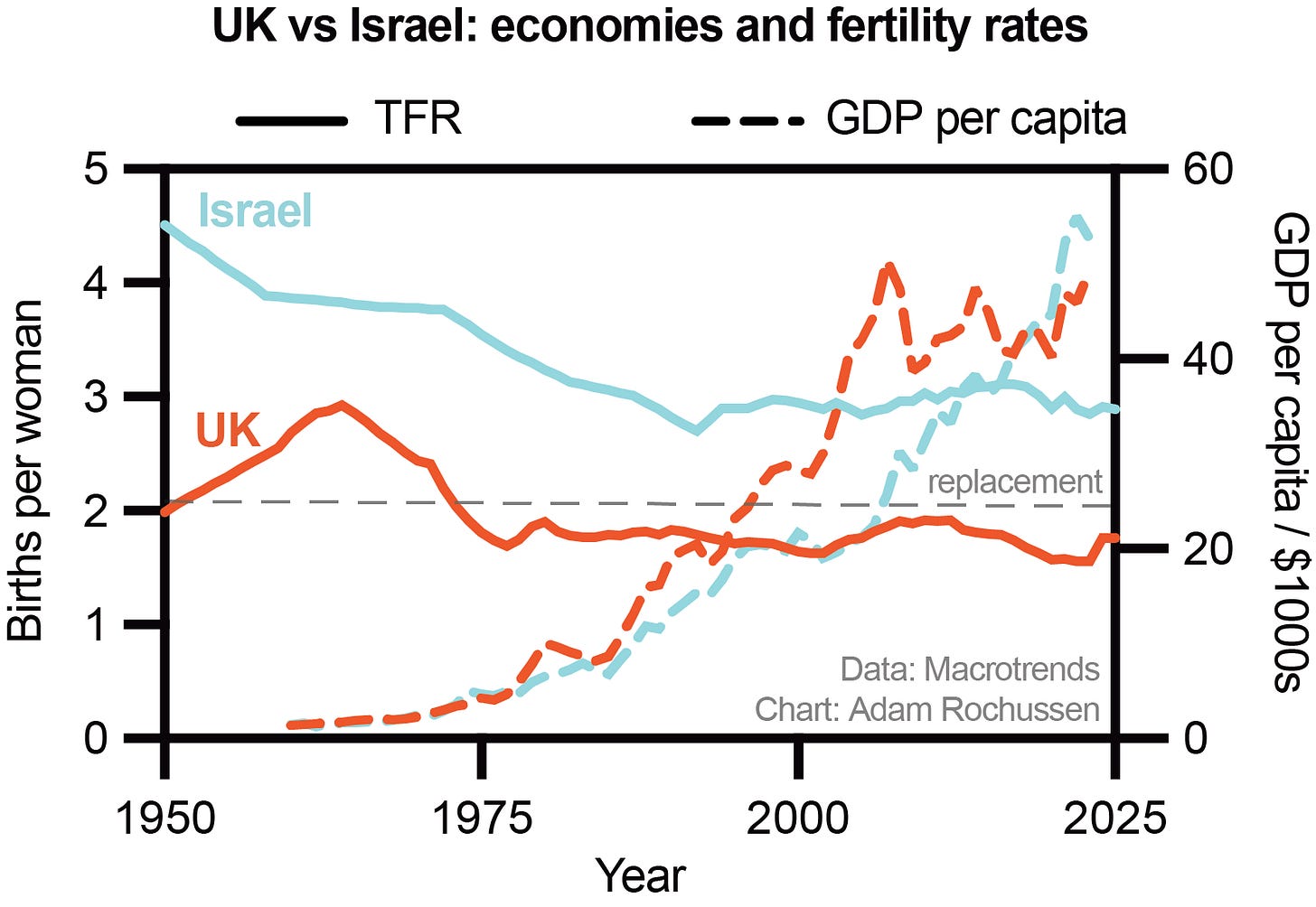Preventing population collapse
Authoritarian solutions can work. Libertarian solutions will work.
The fertility rate crisis
It takes two humans to produce a human. For humanity to carry on existing, therefore, each woman (or man—but tracking maternity is easier than paternity) must produce exactly two humans that also go on to create two humans. Since not all little humans make it to the point where they also create other humans, women must, in fact, produce slightly more children for humanity to persist (around 2.1 for developed countries like the UK; above 3.0 in some African countries with high infant mortality rates). Simply put, falling short of this number for a long enough time equals the extinction of humanity. I am morally opposed to this outcome, since humanity *is* morality as far as we can tell (i.e., without humanity, morality ceases to exist).
In many countries now, total fertility rates (TFR, defined as the average number of children birthed per woman across her lifetime) are significantly below 2.2. In the UK, TFR as of 2024 is 1.41. In the US, despite more religiosity and slightly stricter abortion laws, the situation is not much better, with a TFR of 1.61 in 2023. We have largely avoided negative consequences of this by supplementing our populations with immigration, and due to the population lag effect (it takes a while for demographics to change after birth rates change). But it’s not just a western or caucasian issue only. Thailand, El Salvador, and Iran posted 2023 TFRs of 1.21, 1.78, and 1.70 respectively. Even India is now below replacement, at 1.98. East Asia is particularly bad, with Japan at 1.20, China at 1.00, and South Korea at 0.72.
Let’s do some quick maths to put this into perspective. At replacement level, 100 Koreans now would leave 100 Koreans in 100 years. Perfect. With a TFR of 0.72, assuming an average childbearing age of 33 (so three generations in 100 years), 100 Koreans produces only 4 baby Koreans in 100 years time. Numerically, that’s worse than most genocides in human history.
If TFR remains low in these countries, that’s an obvious catastrophe and tragedy. Worse than just the disappearance of humans over time though, the quality of life for the final generations would be terrible (young people run and fund the economy, while those above retirement age only take from what would be an ever shrinking economy).
Globally, the TFR is still just above replacement (around 2.35)—kept afloat by Africa, where some countries have very high TFRs still (e.g. Niger’s is 6.73). Since this demographic fate seems to pervade all advanced economies, we might expect that, once Africa catches up economically, their fate will probably similar too (although correlation doesn’t necessarily imply causation here, and there are mechanisms of causation in both directions).
For those who’ve been paying attention, I’m stating the obvious here. Yet it still shocks me how many intelligent, educated people I speak to think that we are still facing an overpopulation crisis. Perhaps decades of Malthusian depopulation rhetoric from the likes of Bill Gates is to blame, or perhaps the blindspot stems from wishing to distance oneself politically from the Musk’s of the world, who is fervently talking about this issue. Either way, this brief introduction here should hopefully bring some readers up to speed without flogging a dead horse.
The solutions
While population collapse used to be falsely considered a dog whistle for racists and misogynists, it is now garnering much more mainstream attention—a testament to the reality of the issue and the disingenuousness of the ad hominem-ers. A number of thinkers and writers have proposed solutions to the declining fertility rates issue: from
’s focus on marriage rates or housing conditions, to ’s and ’s focus on financial incentives, to ’s focus on fertility tech for aging mothers. I think they are all great, and these will certainly play a role in solving the problem. But all of these solutions work with a fixed desire to have kids, and try to make it easier for people to achieve these desires. In this way, such solutions only address proximate causes, while leaving the underlying desire to have more kids untouched.The reason for this is that, as many have pointed out, women in low TFR countries have fewer kids than they say they actually want to have. The problem is, I think this is bullshit. This is for a couple reasons:
Firstly, people change their minds throughout their lives. A woman may have wanted zero kids until age 35 and then all of a sudden decided she actually wants 3 kids. Logistically, she may not get to three by the end of her reproductive years. This scenario gives rise to stats which show that “women actually want more kids than they have in reality”, but these stats are misleading because it’s obviously true that cultural or political nudges towards a desire for natalism earlier in her life would have given her more years post-change of mind to realise her motherhood goals.
Secondly, people lie (including to themselves). Maybe looking back on her life through rose-tinted glasses, a woman might say that more kids would’ve been ideal. Social scientists know, however, that there is quite the chasm between stated preferences and revealed preferences. It is easy to say that you wanted more kids than you got when you aren’t actually faced with the decision to have more kids anymore. In terms of judging peoples’ actual desires, their actions are probably a better metric than their words. When there’s a will, there’s a way, and if the way wasn’t taken, there probably wasn’t the will. Thus, positive changes in the desire to have kids—addressing the ultimate cause of the issue—actually will be hugely impactful.
With that said, I’d like to weigh in here with two solutions. One is policy-based and I offer it with tongue firmly in cheek. I think it would work, but I can’t in good libertarian faith insist on it. The actual solution I think is already underway. It solves the issue bottom-up by invoking that all-powerful but ever-nebulous cause: culture.
Solution I: Have you tried “kill all the pets”?
If I were a benevolent dictator who wanted to boost fertility rates, this is the single law that I would pass:
Here me out. When I first moved to San Diego I was stunned at how many young people own pets. It wasn’t young families wanting to give their kids the joy of a pet though, it was mainly childless gen Zers and millennials. Pets instead of kids, that is. Lyman Stone has written about how the type of housing and amenities of apartments is anti-natal. He’s definitely got a point here, but developers aren’t demographic engineers—they simply respond to the market. Here in San Diego basically every residential compound I drive past has pet-friendly amenities, from dog parks where you can let them off the leash to pet spa/grooming facilities within the communities themselves. The meme of a “fur baby” isn’t just a meme. In California 47% of dog owners have pushed their dog in a stroller, 36% of Americans give their dogs birthday presents, and pet ownership in America has more than tripled since the 1970s at the same time as birth rates have almost halved.
Breaking down pet ownership by generation is even more revealing. In the US, Gen Z and millennials dominate pet ownership, at 57% (despite only making up ~43% of the population). A stunning 76% of millennials own pets in the US. Further, most of the recent explosion in pet ownership is being driven by Gen Z specifically, with a 43.5% increase in ownership from 2023 to 2024 alone (interestingly, mainly driven by men). Gen Z, despite being at a stage in life that most would consider to be less amenable to pet ownership, exhibit the highest rate of multiple pet ownership out of any generation, at 70%.
It is the attitudes that American pet owners have towards their pets that prove my point. According to an October 2024 Harris poll, 82% of pet owners say their pet is like their own child. When US pet owners were asked to choose between pets and children, 39% said both, 43% chose pets, and only 18% chose children over pets (!).
Many of my Gen Z friends complain that having kids is just too expensive. Disregarding the fact that Gen Z are unprecedentedly rich, this doesn’t seem to stop them from getting pets, which are also very costly. In fact, if you plot the fertility rate versus the percentage of dog owners who would spend $4k to save their dog, by US state (don’t ask me why this data is even a thing), you get a pretty neat negative correlation.
Yes yes there are a gazillion confounders here, I know, and it’s basically GDP vs fertility again. Still, I don’t think it’s wildly implausible to hypothesise that pet owners without kids would spend more on their “fur babies” than pet owners with kids. There seems to be a misdirection of caregiving resources here. Indeed, as
has recently pointed out, pet expenditure and birth rates in the US are inversely correlated over time.When I speak to people about kids, the main reason why they don’t want to have them, besides cost, is just that they can’t be arsed with the hassle. Kids require effort and lifestyle sacrifices. And they’re messy. One friend of mine cited the inevitable months of suboptimal sleep as the main reason why she never wants to have a kid (!).
Pets give you a small dose of this hassle, especially dogs, meaning that pets syphon caregiving energy that could otherwise be spent on a small human. There is a piece of conventional wisdom that having a pet is a good way to “practice” for a couple thinking of having kids. I think this is bad advice. If people are already umm-ing and ahh-ing about having kids with their busy and self-centred lives, throwing a pet into the mix more or less seals the deal against kids for the next few years.
On the other hand, the main short term benefits of kids are a sense of purpose and responsibility that come from having a small thing to look after that depends on you, love/cuteness/adoration etc, and the romantic relationship-enhancing effect of having a shared goal with your partner. All of these things are provided by a pet too. Thus, pets relieve any buildup of parental sentiment while syphoning resources (time/money/energy) that could go towards an actual human.
Recently, I’ve recently seen a few instances of science communicator Andrew Huberman getting dragged on X for being childless at 50 years old, and therefore not being a good masculine role model (I think these accusation are rather harsh). Andrew has spoken extensively of his close relationship with his bulldog, Costello. Huberman was around 35 years old when he got Costello—close to the median age of first-time fatherhood for college educated Americans. I can’t help but wonder if an alternate universe Huberman, deprived of Costello’s affection and full to the brim with caregiving capacity, would have settled down and had kids earlier in his life.
The no pet policy is sound. It focuses on mammalian pets because I think they’re the main culprits for stealing caregiving resources and desire from potential humans. I could flesh it out more, talking about the mutability of the 40yo cutoff, or concessions for the gays and the infertile, but I’ll stop now. No pets would work, but not in a liberal democracy. Let me now offer a realistic solution.
Solution II: Nothing
As I have already alluded to, the desire to have kids is a prerequisite for all enabling factors like fertility tech, tax incentives, or housing availability. For every argument that a lack of X is limiting fertility rates, there are counter-examples where a sufficiently high desire to have kids trumps a lack of X.
For example, it seems to have become an axiomatic truth that young adults won’t settle down and have kids unless they can own a home. But this is obviously nonsense. There are many young families who rent in perpetuity. There are many young families who thrive living in apartment blocks, not houses. Equally, while money can be used to incentivise parenthood, our GDP per capita vs fertility rates analysis clearly shows that wealth isn’t a requirement for having kids. Further, comparing fertility and GDP per capita within one country over time also shows that more money doesn’t equal kids. As I’ve already stated: when there is a will, there is a way. Proximate solutions are great, but the ultimate solution is the desire to have kids. The problem of declining fertility rates needs a bottom-up solution, not top-down ones. But how can we possibly control people’s desires to have kids? You don’t have to be a determinist to already know the answer: culture.
The capacity for culture to outweigh all other birthrate-limiting factors is perhaps best exemplified by Israel. Israel is a rich, progressive country with a GDP per capita greater than the UK and similar home ownership rates as the UK (~65%). Despite this, and their constant threats of war and terrorism, it’s TFR has been stable since the 1990s at around 2.9—higher than peak baby boom UK. Yes, Israel has a swathe of pro-natal policies, but, as I’ve argued before, in democracies, policy is downstream of culture. Israel’s pro-natal policies stem from their pro-natal culture that reaches back to their founding as a country. Politicians follow the desires of the people, and the desires and behaviours of the people en masse is culture.
When we lift the bonnet of our culture over the past several decades, our low fertility rates immediately make sense. It’s no secret that parenthood goes largely uncelebrated, and the desire to have kids has been culturally suffocated. The corporate world is incentivised to keep all adults in the workforce, governments enjoy the double tax intake per family, and the entertainment industry has ridden the wave of sex-positive feminism which rejects the value of the family and upholds the value of singledom and self-prioritisation. The sitcom Friends is probably the archetypical example of the ousting of the nuclear family, but there are many such cases. Moreover, DINKism (Dual Income No Kids) is at its peak right now, as social media and the dopamine economy has worked to glorify what I call the “gap year lifestyle”: no commitments and an obsession with travelling and new experiences. Pleasure-seeking and suffering-avoidance have been the guiding moral principles for gen Z and millennials.
Which forces work on the nebulous behemoth that is “culture”? What’s the secret ingredient here? Is it something that can even be externally steered? Sort of.
Homeostasis describes biological systems that, when pushed in one direction, automatically revert to the baseline. Blood glucose concentration is homeostatic. When we eat a cookie, glucose concentration in our blood rises. The pancreas responds by releasing insulin, which works to bring glucose back down to normal levels, which in turn shuts down insulin production. This course-correcting dynamic exists at every level of biology, from cells all the way up to populations. Indeed, I propose that human fertility rates are strongly homeostatic.
One mechanism for this is basic Darwinism. People tend to inherit culture and beliefs from their parents (twin and genome-sequencing studies have shown political ideology is highly genetic). People who culturally do not value parenthood will have fewer children than those who do. After several generations, people who value parenthood will dominate the gene and meme pools (in the Dawkinsian sense). We are already seeing this in real time with much higher birth rates among conservatives versus progressives, as covered by
in the Financial Times.In terms of cultural cycles, I think millennial DINKism might already be inducing a counter-cultural swing. Slow-mo shots of your girlfriend (of 10 years) skipping through the streets of Santorini were cool in 2016, but in 2025 DINKs are just a bit cringe and sad. Gen Z and alpha, having waded through the swamp of dopamine saturation that was the COVID lockdowns, are now after meaning, not thrills, as indicated by their resurgent religiosity. The full cultural reckoning against DINKism will come when the DINKs enter middle- and old-age. Having the disposable income to fly to the Maldives for a week every year hardly makes up for spending the Christmases of your 40s and 50s alone, or incurring injury or illness in your 60s and 70s and having nobody that will sleep in a stiff chair by your bedside as you recover.
The New York Times published a piece last year titled “The Unspoken Grief of Never Becoming a Grandparent”. It is a depressing read about how would-be grandparents are working with therapists to help reinforce the self-delusion that its fine that their kids aren’t having kids. Their childless children obviously don’t see their anti-natalism as selfish, and even if it was, they’re entitled to put themselves first! The real tragedy will come when they realise, in their 50s perhaps, that the real act of selfishness was on the part of their younger selves against their older selves. The best advert for pro-natalism will be old anti-natalists.
Some cultural shifts are already underway. The aforementioned rising religiosity of gen Z can be expected to create a noticeable bump in fertility rates in the next 5-10 years. DINKs have been met head-on with TradWives, much to the annoyance and confusion of third wave feminists. Donald Trump, regardless of what you think of him, has shifted the Republican Overton window regarding IVF in a pro-science and pro-natal direction. Even left wing British politicians are now ringing the fertility bell.
In media and the arts, the nuclear family is starting to return to centre stage. Apple released a deeply emotional pro-family Christmas ad last year that has now been viewed over 51 million times, while Volvo’s beautiful pro-natal advert received an overwhelmingly positive response. Comedy giant Andrew Schulz sold out arenas across the country on his “Life” tour last year. The show, now available as a Netflix special, is an explicitly pro-natal comedy set about his and his wife’s successful quest for parenthood. He now regularly posts about the joys of fatherhood to his 4.5 million Instagram followers.
While a childless Kamala Harris failed to convince the nation of her leadership skills, the favoured Republican and Democrat candidates for 2028—JD Vance and Gavin Newsom—have seven children between them (I mean … with their wives that is). Perhaps the final nail in the coffin for anti-natalist culture will be when popstar-cum-cult leader Taylor Swift and her politically opaque fiancé announce that they are expecting their first child. I’m quite certain that the attitude towards motherhood of millions of gen Z and millennial women will turn on a dime once Jack Antonoff has penned his first pro-natal Swiftie anthem.
The Economist recently published an opinion piece arguing that we should be optimistic about the fertility crash. Their reason isn’t because they think we can solve the problem, but because a world without any (young) people won’t actually be that bad (because “AI”—seriously). Poppycock, I say. We should be optimistic, but because we are are solving the problem already. Much like the secret ingredient to Mr Ping’s famous secret ingredient soup in the 2008 film Kung Fu Panda, the secret ingredient to solving fertility rates is nothing. Cultural homeostasis is doing its thing and we can expect a course correction soon.
I don’t want to downplay the years of work of pro-natal advocates here. My thesis here is that the cultural tide is already turning. In other words, the pro-natalists have succeeded in their task of highlighting the issue. Pro-natalism is the most human and the most common sense position to have. When suppressive cultural forces are removed, as they are being, the eons-old status quo—that having kids is a good thing—will resume.
I also don’t want to downplay the capacity for top-down solutions to ameliorate our demographic issues. There will undoubtedly be a further dip before we see a rise in birth rates, and economic incentives or biotechnological assistance will be important buffers to smooth out the ride as culture turns pro-natal again.
The bottom line is that having kids is just a good idea—for yourself and for others. When allowed to spread, good ideas are culturally infectious. Once the cultural appetite for pro-natalism is there, policies will follow, our ever-improving fertility tech will gain usage, and the pendulum will begin to accelerate in the other direction. People spoke of a “vibe shift” when Trump won the presidency last year: a shift towards nationalism; a resurgence of masculinity; a return of American exceptionalism. I think pro-natalism is hitching a ride.
If you liked this essay, please like this essay.
The comments section is public, and endeavour to respond to them all. If you wish to contribute criticisms of my ideas, please do so constructively.










There are 8 billion people already. More than enough to last a million years at below replacement levels. I really don't think "population collapse" is a legitimate issue for sane people to seriously fret about.
This is giving privileged author